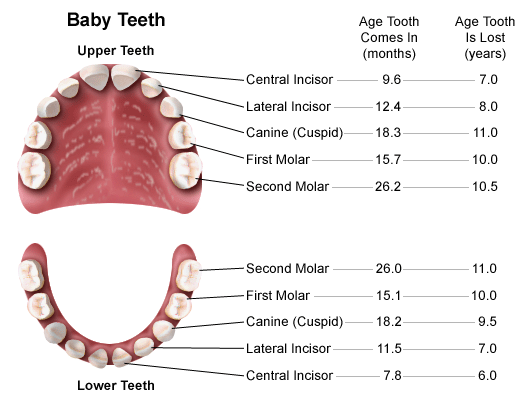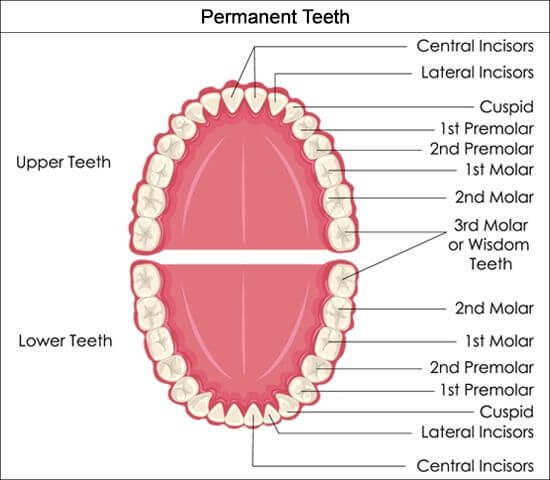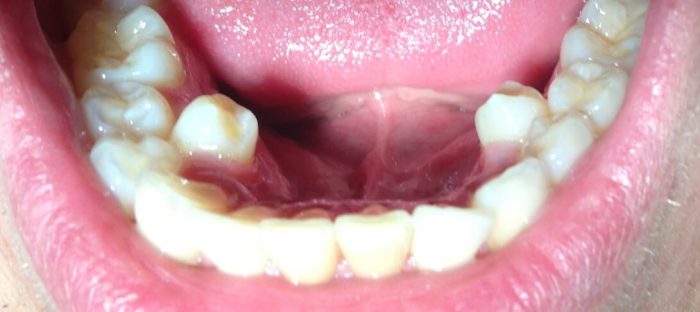Supernumerary teeth are extra teeth that should not be present in the human dentition. The condition is also known as hyperdontia, and affects 0.15-3.9% of the population. Adults with this condition have more than 32 permanent teeth, while the affected children have more than 20 primary teeth. Supernumerary teeth are more prevalent in adults than in children. Men are more prone to develop supernumerary teeth than women. Left untreated, hyperdontia can lead to a number of problems, from crowding, rotation, and misalignment, to tooth eruption in the nasal cavity. Read on to get the facts you need to know about supernumerary teeth.
The Normal Human Dentition
In order to completely understand the answer to the question “what is a supernumerary tooth?” you need to know a bit about the anatomy of the mouth.
During childhood, the average person develops 20 baby teeth. The teeth usually begin to emerge from the gums around 6 to 12 months of age.
Permanent teeth develop in the gum line and gradually work their way toward the surface of the gum line. In the process, they push the baby teeth out of place. The teeth become wiggly and loose, and then they fall out. Below you can see a chart of normal primary and permanent teeth.
In addition to the 20 primary teeth, adults have 12 more molars that come in during late childhood and adolescence. This means that all in all, the average adult has 32 teeth or 28 if their wisdom teeth require removal.
Supernumerary Teeth Definition
A supernumerary tooth is an extra tooth. If a child has a supernumerary tooth, it means that they have 21 rather than 20 teeth. In an adult, it would mean 33 teeth.
Only an estimated 1 to 4 percent of the population will develop a supernumerary tooth. Those who do are said to have a conditional called hyperdontia, which just means having extra teeth.
It’s possible that your kid has a primary supernumerary tooth. However, most often, the problem affects permanent teeth and is diagnosed in adults. In very rare cases, a person with hyperdontia may have more than one supernumerary tooth.
A supernumerary tooth may grow in a row with the other teeth, in front of the teeth, behind them or even from the roof of the mouth.
What Causes a Supernumerary Tooth?
While the answer to the question what is a supernumerary tooth is clear, the reason why a person ends up with one is more mysterious.
Scientists do not know exactly what causes supernumerary teeth. Some think that the problem is purely genetic. This means that you are more likely to grow extra teeth if your parents have hyperdontia. Others think it is environmental and due to something that kids are exposed to, but what that might be is unknown.
Boys are twice as likely to develop hyperdontia than girls, but again, scientists don’t know why.
A number of genetic diseases have hyperdontia as a symptom, including:
- Anderson-Fabry disease;
- Angio-osteohypertrophy syndrome;
- Apert syndrome;
- Cleidocranial dysplasia;
- Crouzon syndrome;
- Down syndrome;
- Ehlers-Danlos syndrome;
- Gardner syndrome;
- Hallermann-Streiff syndrome;
- Oral-facial-digital syndrome type 1;
- Sturge-Weber syndrome;
Supernumerary Tooth Diagnosis
In many cases, supernumerary teeth are just diagnosed visually. A dentist can usually spot one either trying to break through the gums or once it has emerged. A dental x-ray can also reveal supernumerary teeth that have not yet emerged from the gum line or have been impacted, meaning they are stuck in place and cannot emerge.
If you or your child has a supernumerary tooth, your dentist will likely do a series of x-rays to see what effect the extra tooth is having on the rest of your mouth.
Do you Have to Treat Supernumerary Teeth?
In nearly all cases, you will need to treat a supernumerary tooth for one or all of the following reasons:
- The extra tooth can cause other teeth to become crooked or otherwise misaligned.
- It can prevent healthy permanent teeth from emerging through the gumline.
- The supernumerary tooth may be malformed or fragile.
- There may not be enough room for the tooth to emerge, and it can cause pain and pressure if it is impacted.
- The extra tooth may be unsightly.
- The extra tooth may interfere with your ability to chew, swallow or speak properly.
- There is evidence that suggests that a supernumerary tooth could increase your risk of developing cysts and tumors in your mouth if left in place.
Supernumerary Teeth Treatment
In some cases, dentists will just leave a baby supernumerary tooth may in place, and allow it to fall out on its own. But most of the time, you need to treat the problem.
The treatment for a supernumerary tooth is extraction or pulling out the tooth. Sometimes, this may be able to be done in the dentist’s office while you’re awake. Most of the time, an oral surgeon performs extractions with partial or full anesthesia.
Conclusion
Now that you know the answer to the question “what are supernumerary teeth?” and understand why one can be a cause for concern, it’s important that you work with your dentist to come up with a treatment plan for you or your child. With your dentist’s help, you can reduce the risks of a supernumerary tooth. Have you discussed with your dentist about supernumerary teeth? What was your experience? Do you have further questions? Just leave us a comment below!




Oh wow! That seems pretty scary! I never knew this was even possible to be honest! Not to mention it looks like it could be painful and make it more difficult for everyday oral care.
Hello, Jim!
Supernumerary teeth are definitely unpleasant to have. However, luckily, you can get rid of the problem by going to the dentist and getting the teeth extracted.
Have a lovely day!